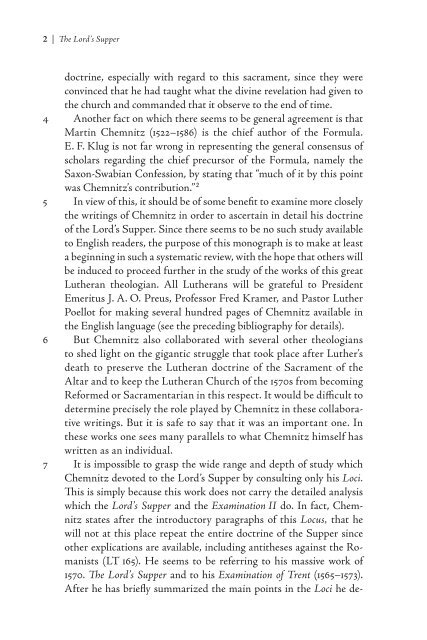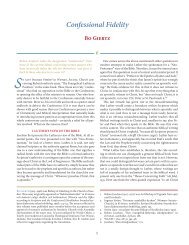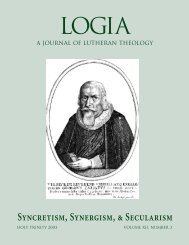The Lord's Supper in the Theology of Martin Chemnitz Bjarne - Logia
The Lord's Supper in the Theology of Martin Chemnitz Bjarne - Logia
The Lord's Supper in the Theology of Martin Chemnitz Bjarne - Logia
You also want an ePaper? Increase the reach of your titles
YUMPU automatically turns print PDFs into web optimized ePapers that Google loves.
| <strong>The</strong> Lord’s <strong>Supper</strong><br />
doctr<strong>in</strong>e, especially with regard to this sacrament, s<strong>in</strong>ce <strong>the</strong>y were<br />
conv<strong>in</strong>ced that he had taught what <strong>the</strong> div<strong>in</strong>e revelation had given to<br />
<strong>the</strong> church and commanded that it observe to <strong>the</strong> end <strong>of</strong> time.<br />
4 Ano<strong>the</strong>r fact on which <strong>the</strong>re seems to be general agreement is that<br />
Mart<strong>in</strong> <strong>Chemnitz</strong> (1522–1586) is <strong>the</strong> chief author <strong>of</strong> <strong>the</strong> Formula.<br />
E. F. Klug is not far wrong <strong>in</strong> represent<strong>in</strong>g <strong>the</strong> general consensus <strong>of</strong><br />
scholars regard<strong>in</strong>g <strong>the</strong> chief precursor <strong>of</strong> <strong>the</strong> Formula, namely <strong>the</strong><br />
Saxon-Swabian Confession, by stat<strong>in</strong>g that “much <strong>of</strong> it by this po<strong>in</strong>t<br />
was <strong>Chemnitz</strong>’s contribution.” 2<br />
5 In view <strong>of</strong> this, it should be <strong>of</strong> some benefit to exam<strong>in</strong>e more closely<br />
<strong>the</strong> writ<strong>in</strong>gs <strong>of</strong> <strong>Chemnitz</strong> <strong>in</strong> order to ascerta<strong>in</strong> <strong>in</strong> detail his doctr<strong>in</strong>e<br />
<strong>of</strong> <strong>the</strong> Lord’s <strong>Supper</strong>. S<strong>in</strong>ce <strong>the</strong>re seems to be no such study available<br />
to English readers, <strong>the</strong> purpose <strong>of</strong> this monograph is to make at least<br />
a beg<strong>in</strong>n<strong>in</strong>g <strong>in</strong> such a systematic review, with <strong>the</strong> hope that o<strong>the</strong>rs will<br />
be <strong>in</strong>duced to proceed fur<strong>the</strong>r <strong>in</strong> <strong>the</strong> study <strong>of</strong> <strong>the</strong> works <strong>of</strong> this great<br />
Lu<strong>the</strong>ran <strong>the</strong>ologian. All Lu<strong>the</strong>rans will be grateful to President<br />
Emeritus J. A. O. Preus, Pr<strong>of</strong>essor Fred Kramer, and Pastor Lu<strong>the</strong>r<br />
Poellot for mak<strong>in</strong>g several hundred pages <strong>of</strong> <strong>Chemnitz</strong> available <strong>in</strong><br />
<strong>the</strong> English language (see <strong>the</strong> preced<strong>in</strong>g bibliography for details).<br />
6 But <strong>Chemnitz</strong> also collaborated with several o<strong>the</strong>r <strong>the</strong>ologians<br />
to shed light on <strong>the</strong> gigantic struggle that took place after Lu<strong>the</strong>r’s<br />
death to preserve <strong>the</strong> Lu<strong>the</strong>ran doctr<strong>in</strong>e <strong>of</strong> <strong>the</strong> Sacrament <strong>of</strong> <strong>the</strong><br />
Altar and to keep <strong>the</strong> Lu<strong>the</strong>ran Church <strong>of</strong> <strong>the</strong> 1570s from becom<strong>in</strong>g<br />
Reformed or Sacramentarian <strong>in</strong> this respect. It would be difficult to<br />
determ<strong>in</strong>e precisely <strong>the</strong> role played by <strong>Chemnitz</strong> <strong>in</strong> <strong>the</strong>se collaborative<br />
writ<strong>in</strong>gs. But it is safe to say that it was an important one. In<br />
<strong>the</strong>se works one sees many parallels to what <strong>Chemnitz</strong> himself has<br />
written as an <strong>in</strong>dividual.<br />
7 It is impossible to grasp <strong>the</strong> wide range and depth <strong>of</strong> study which<br />
<strong>Chemnitz</strong> devoted to <strong>the</strong> Lord’s <strong>Supper</strong> by consult<strong>in</strong>g only his Loci.<br />
This is simply because this work does not carry <strong>the</strong> detailed analysis<br />
which <strong>the</strong> Lord’s <strong>Supper</strong> and <strong>the</strong> Exam<strong>in</strong>ation II do. In fact, <strong>Chemnitz</strong><br />
states after <strong>the</strong> <strong>in</strong>troductory paragraphs <strong>of</strong> this Locus, that he<br />
will not at this place repeat <strong>the</strong> entire doctr<strong>in</strong>e <strong>of</strong> <strong>the</strong> <strong>Supper</strong> s<strong>in</strong>ce<br />
o<strong>the</strong>r explications are available, <strong>in</strong>clud<strong>in</strong>g anti<strong>the</strong>ses aga<strong>in</strong>st <strong>the</strong> Romanists<br />
(LT 165). He seems to be referr<strong>in</strong>g to his massive work <strong>of</strong><br />
1570. <strong>The</strong> Lord’s <strong>Supper</strong> and to his Exam<strong>in</strong>ation <strong>of</strong> Trent (1565–1573).<br />
After he has briefly summarized <strong>the</strong> ma<strong>in</strong> po<strong>in</strong>ts <strong>in</strong> <strong>the</strong> Loci he de-




